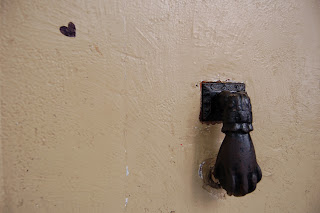This was a restoration and remodelling project taken on by Gaudi and Josep Jujol. They achieved this organic look by eliminating the sharp edges and adding a splash of colour with chipped tile mosaics on the façade, giving the house an organic Art Nouveau expression.
The bone-like columns give the house its colloquial nickname, The House of Bones (Casa dels ossos). The balconies have a tortured appeal with similarities to the mask of the Phantom of the Opera. (or maybe a fish’s skull?)
Poseidon’s crown?
Whatever the angle in Casa Batlló, Poseidon had to have forged this from his trident. Gaudi brings this oceanic language into his work allowing you to flow and transition between spaces.
The ceiling in the lounging area is the most interesting feature on the first floor, compelling you to be drawn in by its whirlpool appeal.
Casa Batllo’s roof has often referred to as the dragon slain by St. George (St. Jordi being the patron saint of Catalan).












